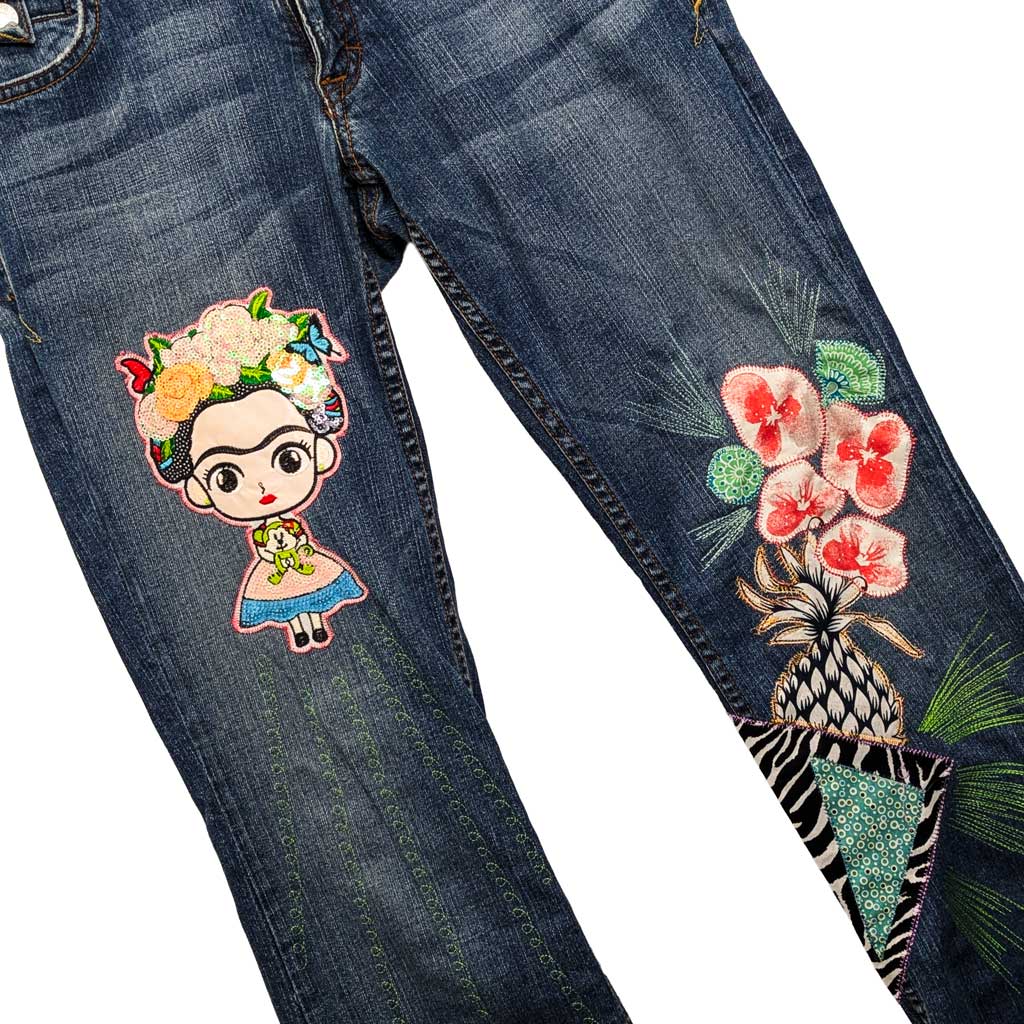Vintage Denim & Wearable Art
A Synthesis of Creativity, Consciousness, and Counterculture
Wearable art is an extraordinary discipline that exists at the dynamic convergence of fine art, fashion, and meticulous craft. It fundamentally redefines the purpose of clothing, transforming utilitarian garments into unique, mobile sculptural expressions.
Unlike industrial fashion, which is dictated by the mandates of scale, seasonal trends, and commercial expediency, wearable art prioritizes individuality, a compelling artistic statement, and an obsessive attention to handmade craftsmanship.
This category of creative expression, which first gained widespread recognition during the counterculture ferment of the 1960s and 1970s, has evolved into a crucial vehicle for the use of reclaimed and upcycled materials, thereby creating a profound, essential link between aesthetic innovation and urgent ecological responsibility.
The Historical Roots of Re-making as Social Rebellion
The fundamental human practice of re-working and re-making clothing originated out of sheer necessity—a pragmatic response to poverty or wartime scarcity, as evidenced during periods like the Great Depression and both World Wars. However, its transition into a deliberate, powerful cultural and political statement is most vividly traceable to the youth movements of the 20th century.
Here, customized attire was intentionally deployed as a direct challenge to established social norms, mainstream authority, and the rapidly growing monotony of industrial consumer culture. The act of personalizing one’s clothing became synonymous with carving out a unique, self-determined identity.
The Counterculture of the 1960s: Peace and Patchwork
The Hippie and broader counterculture movements of the 1960s marked a significant cultural pivot. They championed a fervent return to handmade goods, openly rejecting industrial production models and embracing non-Western, communal, and spiritual aesthetics.
This shift fueled a massive resurgence in fiber arts and DIY textile techniques. Young people used bright tie-dye, intricate patchwork, detailed hand-embroidery, and appliqué to dramatically transform simple, often thrifted or second-hand, garments into vibrant, unique, and highly personal canvases.
This form of alteration was wearable art functioning as a peaceful, anti-establishment declaration. The laborious process of hand-decorating clothes was a symbol of leisure, freedom, and a deliberate disconnection from the corporate work ethic. It promoted a connection to nature and to craft-based traditions that were being eradicated by mass production. It communicated a message of cultural universalism and non-conformity, where the clothing itself became the signature of a shared yet individualistic philosophy.
The Visceral Aesthetic of Punk: DIY Anarchy
The Punk subculture that violently erupted in the mid-1970s seized the concept of re-making and pushed it to a confrontational, intensely visceral extreme. Emerging from deep socio-political disillusionment and economic stagnation, punk fashion became the aggressive, visual embodiment of the DIY (Do It Yourself) ethos and a strident anti-consumerist position.
Punk’s approach to clothing was characterized by deconstruction, deliberate defacement, and aggressive reconstruction. Punks systematically sought out the most affordable, second-hand, or military surplus clothing, which they then intentionally mutilated, adorned with abrasive graphics, and often reconstructed with non-traditional fastenings.
Aesthetic of Offense: Utilitarian items, traditionally hidden or associated with danger, such as safety pins, razor blades, heavy chains, padlocks, and even repurposed trash materials like bin liners, were transformed into provocative, anarchic accessories. This act turned mundane objects into potent symbols of social chaos and personal resistance against a structured, conformist society.
The Wearable Manifesto: Leather jackets, denim vests, and plain t-shirts served as mobile, personal manifestos. They were heavily customized with hand-painted band logos, political slogans, threatening imagery, and patched-on slogans. This intensely personal and confrontational customization was a powerful form of public, wearable art, engineered specifically to shock the establishment and establish a visible, defiant identity.
Groundbreaking designers like Vivienne Westwood and her partner Malcolm McLaren, operating their influential ‘SEX’ boutique on King’s Road, codified this raw punk aesthetic. They proved definitively how aggressively customized, upcycled, and deliberately sexually transgressive fashion could be synthesized into a devastatingly high-impact form of both social commentary and legitimate art.
Their work established the legacy of the garment as a weapon of cultural critique.
The Ethos of Transformation: Reclaimed Materials and Upcycling
The concept of upcycling is not merely a supplementary trend in wearable art; it is central to its philosophical core. Upcycling involves the creative reuse of discarded objects, waste materials, or unwanted products to generate a new creation of superior quality or environmental value than the original.
This practice significantly distinguishes itself from traditional recycling, which necessitates breaking down materials into their raw state for re-manufacture. Instead, upcycling is a process of direct, imaginative transformation, turning perceived waste into unique, often high-value artistic products.
For the wearable artist, reclaimed materials offer far more than just a cost-effective resource; they are complex vessels of history, inherent narrative, texture, and unpredictable form. Artists working in this medium demonstrate ingenuity by incorporating materials ranging from obsolete circuit boards, oxidized industrial metal scrap, and various forms of plastic waste to antique book pages, discarded leather, and diverse vintage textiles.
The construction of these pieces often demands a specialized set of technical skills—including welding, detailed collage work, complex assemblage, and traditional textile arts like intricate quilting, free-motion embroidery, and careful patchwork—to successfully manipulate the non-traditional “raw” materials. The final artwork inherently carries a potent environmental critique against the relentless waste streams and disposable culture of modern consumerism.
By making the garment itself out of debris, the artist elevates the clothing into a dynamic form of eco-conscious activism and an eloquent statement about scarcity and resourcefulness.
This focus on reuse is a deliberate act of slowing down the relentless fashion cycle. By investing immense time and specialized skill into transforming pre-existing items, wearable art resists the transient nature of fast fashion and instead promotes the value of permanence, narrative depth, and unique personal expression. Every stitch, weld, or placement of reclaimed material is a documented choice, contributing to the item’s singular identity.
Wearable Art Today: A Platform for Sustainability and Sculptural Statement
In the 21st century, the symbiotic relationship between wearable art and reclaimed materials has grown into a significant global movement, driven largely by existential anxieties concerning climate change, resource depletion, and the staggering waste generated by the fast fashion industry.
Contemporary wearable artists continue the profound countercultural tradition of using the human body as a pedestal for their medium, aiming to provoke complex conversations about sustainability and consumption. By transforming modern, discarded materials—from colorful plastic packaging, defunct rubber tubes, and tangled fishing nets to obsolete electronic components—they produce pieces that are frequently sculptural, kinetic, and rich with symbolic meaning.
This modern incarnation of the art form compels both the wearer and the audience to deeply examine the lifecycle of products, the hidden ecological and labor costs of globalized consumerism, and the immense creative potential that resides within objects deemed unworthy or simply “trash.”
The modern global emphasis on upcycling in wearable art represents a powerful, sophisticated continuation of historical re-making traditions. It is a fusion that incorporates the Arts and Crafts movement’s dedication to handmade quality, the Hippie commitment to ecological consciousness and natural materials, and the Punk rejection of commercial conformity.
Ultimately, wearable art—especially that which is masterfully constructed from reclaimed materials—is a continually evolving, vibrant field that is fundamentally dedicated to exploring themes of identity, ecological consciousness, material transformation, and the enduring power of the handmade narrative.
Notable Upcycled & Reclaimed Wearable Art Designers
Nicole McLaughlin
Focus: A pioneer in the viral, conceptual upcycling movement. She creates whimsical, often humorous, and always thought-provoking wearable accessories and garments from highly unconventional, everyday waste materials (like badminton shuttlecocks, volleyballs, chip bags, or cardboard boxes).
Process: Her work is less about mass-produced items and more about demonstrating the artistic and functional potential of transforming trash, embodying the purest form of contemporary DIY wearable art.
Zero Waste Daniel
Focus: Dedicated to achieving zero waste in the production of his clothing line.
Process: He collects fabric scraps—often discarded by New York City’s garment industry—and pieces them together in intricate, colorful patchwork designs to create unique, wearable items like sweatshirts and tees. His “ReRoll” technique results in vibrant, one-of-a-kind, abstract pieces.
Bode (Emily Bode Aujla)
Focus: Known for its menswear (and now womenswear) that is almost entirely constructed from antique, vintage, and found textiles.
Process: Emily Bode uses materials like vintage quilts, antique grain sacks, domestic linens, and discarded Victorian bedding. Each garment’s history and original flaws are preserved and celebrated, making every piece a unique narrative work of art that honors textile history and craft.
Re/Done (RE/DONE x Levi’s)
Focus: Pioneered the concept of taking apart and reconstructing vintage garments for a modern fit.
Process: They source thousands of vintage Levi’s jeans, deconstruct them, and then reconstruct the fabric into new, modern fits. While more commercial than pure “art,” this process elevated the concept of upcycling vintage material into a sustainable, luxury fashion model.
Bethany Williams
Focus: A UK-based designer who champions social and environmental change. Her collections are produced using recycled, deadstock, and organic materials.
Process: Williams often collaborates with charities (like food banks and women’s centers) to highlight social issues. Her work frequently incorporates bright patchwork, printed patterns on recycled cardboard, and other textile waste, directly linking her aesthetic with community-focused activism.
1/OFF Paris
Focus: A Parisian brand that focuses on upcycling luxury and designer items.
Process: They take iconic pieces from luxury brands (like Burberry trenches, Yves Saint Laurent shirts, or Chanel jackets) and rework them into new, hybrid garments. This process deconstructs the brand power of the original item and transforms it into a contemporary, limited-edition piece of wearable art.
Claudia Williams (llani Creative)
Focus: Known specifically for her conceptual and sculptural wearable art, often seen in major exhibitions and competitions.
Process: She transforms diverse, industrial-level waste materials, such as recycled tyre tubes, scrap metal, and crime stopper tape, into visually striking, elaborate garments and headpieces that blur the line between clothing and sculpture.
These designers demonstrate how the punk spirit of customization and the Hippie ethic of resourcefulness have been professionally formalized into a major pillar of sustainable and artistic contemporary fashion.






